An Introduction to Nature-based Solutions
„The main objective of NBS is to support the achievment of society‘s development goals and safeguard human well-being in ways that reflect cultural and societal values and enhance the resilience of ecosystems, their capacity for renewal and the provision of services“ (IUCN 2020).
In this context NBS are defined as „actions to protect, sustainably manage, and restore natural or modified ecosystems, that address societal challenges effectivly and adaptively, simultaneously providing human well-being abd biodiversity benefits“ (IUCN 2020).
In this context NBS are defined as „actions to protect, sustainably manage, and restore natural or modified ecosystems, that address societal challenges effectivly and adaptively, simultaneously providing human well-being abd biodiversity benefits“ (IUCN 2020).
European Commission‘s definition of NBS: “Solutions that are inspired and supported by nature, which are cost-effective, simultaneously provide environmental, social and economic benefits and help build resilience. Such solutions bring more, and more diverse, nature and natural features and processes into cities, landscapes and seascapes, through locally adapted, resource-efficient and systemic interventions.” (Source: European Commission)
Taking into account the above, NBS can be considered as an umbrella framework for ecosystem-based approaches to address major societal challenges. (IUCN 2020)
Taking into account the above, NBS can be considered as an umbrella framework for ecosystem-based approaches to address major societal challenges. (IUCN 2020)

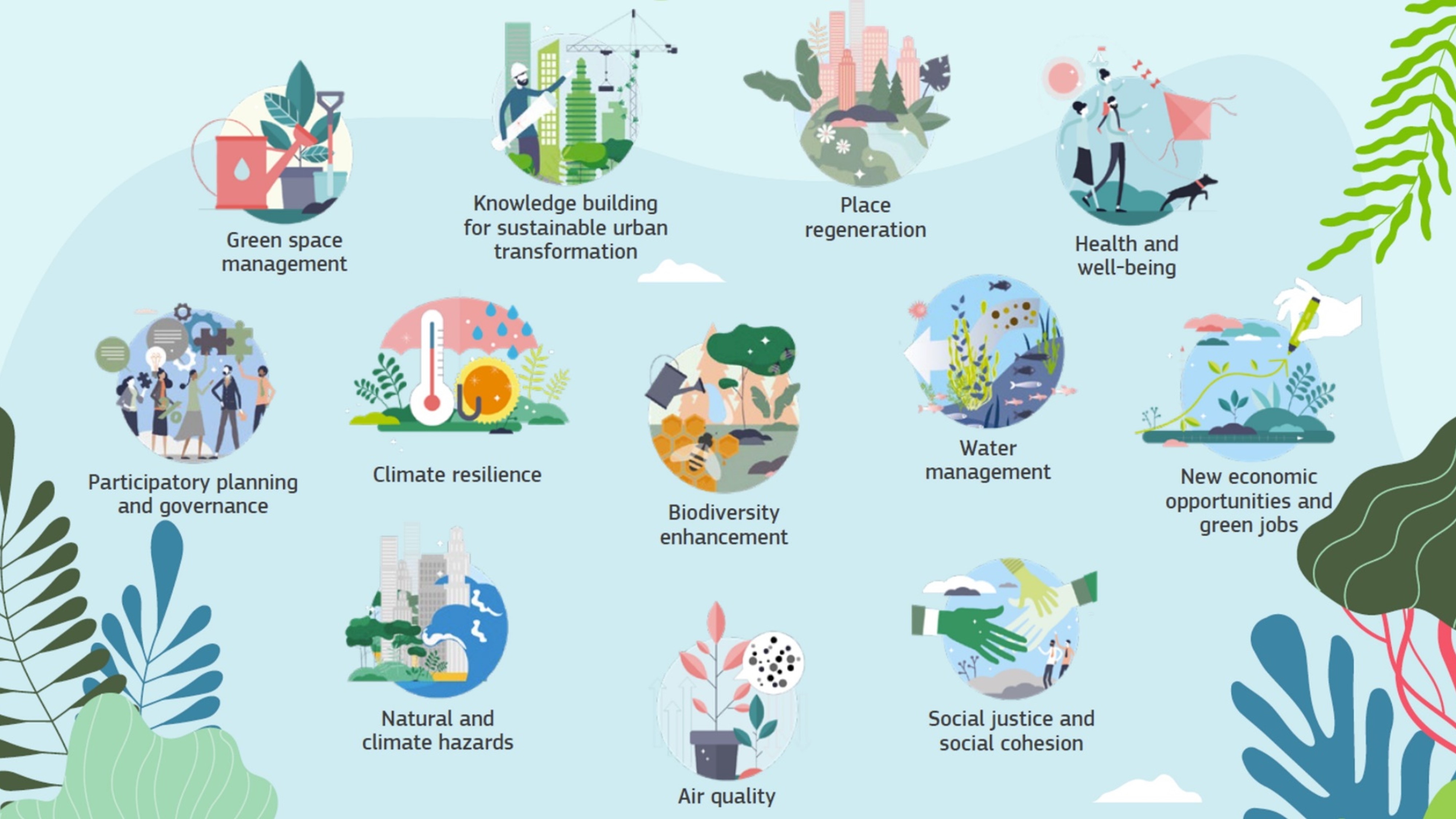
Furthermore, NBS can be regarded as an umbrella term to highlight the commonality of various conservation approaches. The following table summarizes key aspects of different terms associated with and definitions of NBS.
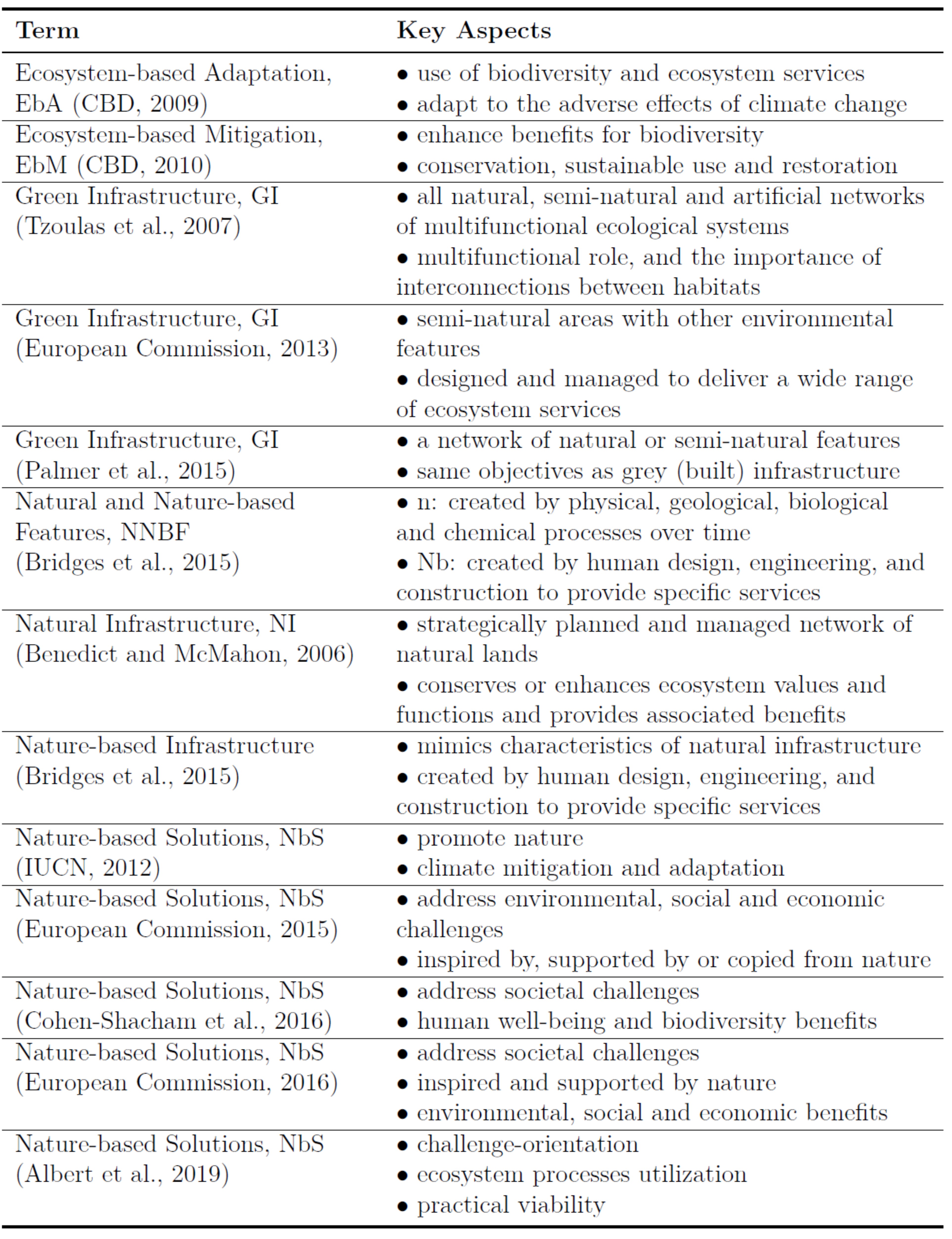
With respect to coastal and flood protection various frameworks and concepts exist, that deals with NBS. Their commonality is to use ecosysteme capacities and services to serve the fields of Water, Nature and People and create (multi) benefits in these fields. According to Jordan (2021) the most prominent are:
- Building with Nature, BwN (Netherlands): The BwN concept develops multi-functional solutions through the use of natural processes and ensures that they are aligned with the interests of both nature and stakeholder
- Ecological Engineering: Ecological Engineering is defined as ‘the design of sustainable ecosystems that integrate human society with its natural environment for the benefit of both’
- Engineering With Nature, EWN (USA): The USACE’s concept of EWN is based on the ‘intentional alignment of natural and engineering processes to efficiently and sustainably deliver economic, environmental and social benefits through collaborative processes’
- Living Shorelines (USA): The Living Shorelines framework pursues several goals, such as shoreline stabilisation, ecosystem services provision or inter- connections between land and water ecosystems
- Soft Engineering: ‘Soft engineering aims to work with nature by manipulating natural systems which can adjust to the energy of the waves and tides to good effect and has the potential for achieving economies whilst minimising the environmental impact of traditional engineering structures’
- Working with Nature, WwN (PIANC, world- wide): PIANC’s WwN concept is centred around the identification and exploitation of ‘win-win solu- tions which respect nature and are acceptable to both project proponents and environmental stakeholders’
As mentioned above NBS use the capacity and services of ecosystems to achieve society‘s development goals and safeguard human well-being. The following table gives an overview of ecosystems services according to the Millennium Ecosystem Assessment.
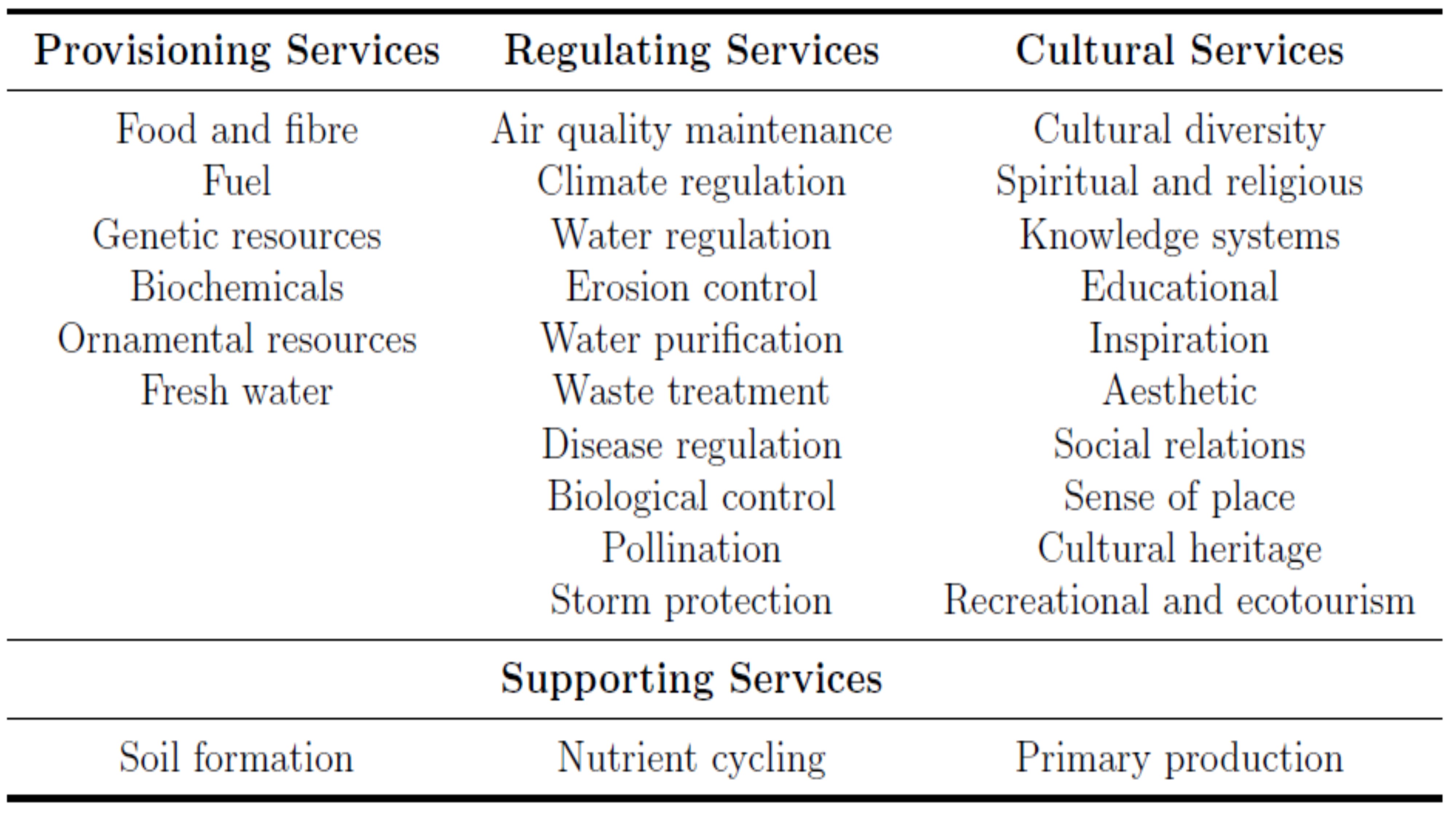
According Eggermont et. al (2015, in EC 2021) NBs can be broadly grouped into three types following their primary objectives or functions and by the level of ecosystem intervention.
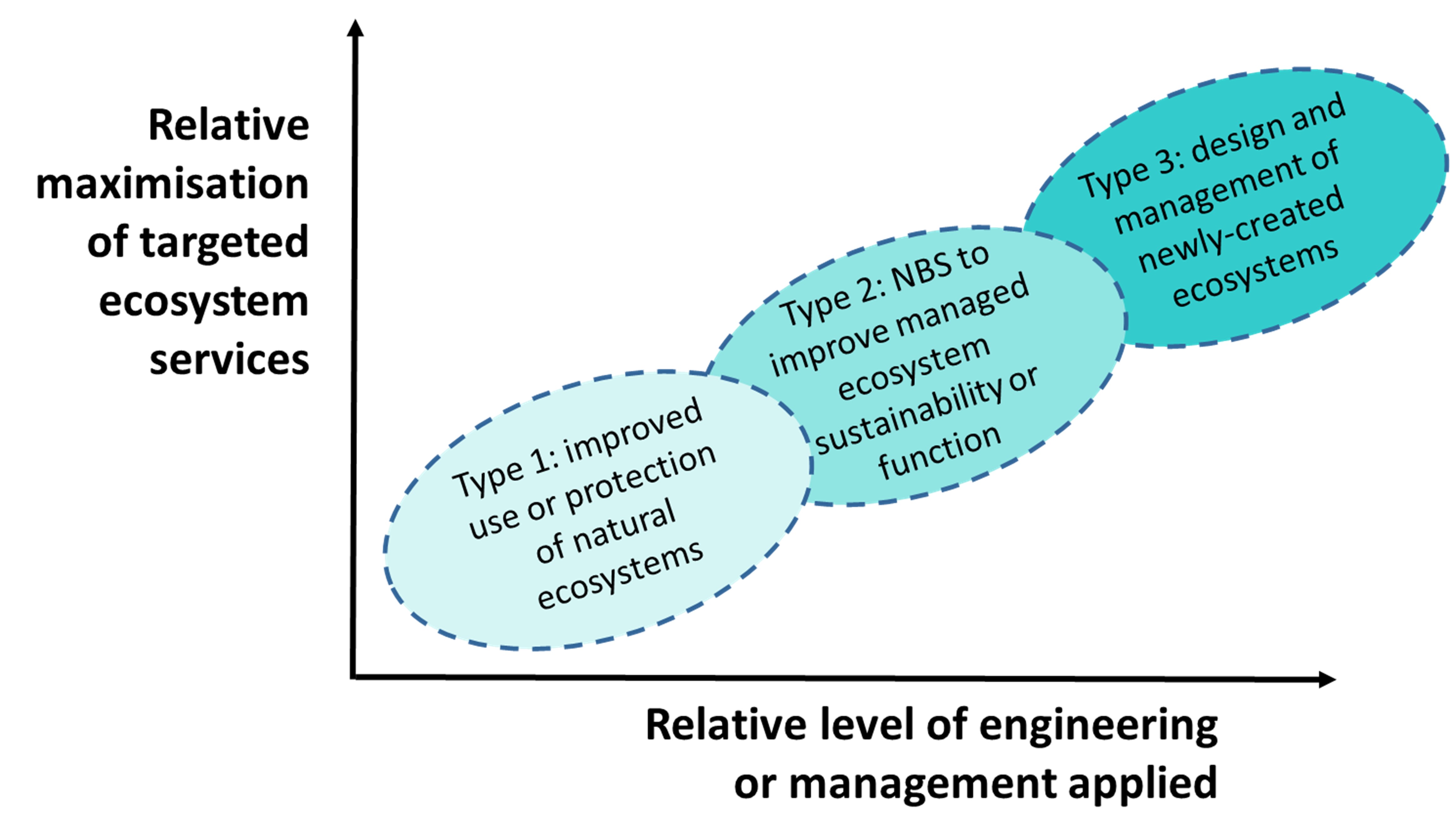
- Type 1 NBS – minimal or no intervention in ecosystems, with objectives related to maintaining or improving delivery of ecosystem services within and beyond the protected ecosystems
- Protection and conservation strategies
- Urban planning strategies
- Monitoring
- Type 2 NBS – extensive or intensive management approaches seeking to develop sustainable, multifunctional ecosystems and landscapes in order to improve delivery of ecosystem services relative to conventional interventions
- Sustainable managment protocols
- Type 3 NBS – characterised by highly intensive ecosystem management or creation of new ecosystems
- Green space
- Trees and shrubs
- Soil conservation and quality management
- Blue-green space establishment or restoration
- Green built environment
- Natural or semi-natural water storage and transport structures
- Infiltration, filtration and biofiltration structures
Assessment of NBS is part of implemention process of NBS. It serves a evidence-based decision making and builds knowedge about the effectivness of NBS actions and measures by highlighting what does and what does not work to achieve the desired goal (of course NBS are implemented to achieve certain goal). (Impact) Assessment systematically and empirically examines the causal effect of the change in the built or natural environment associated with NBS interventions. These effects can be grouped into societal challenges and often impact various multiple dimension simultaneously. Impact assessment is related to the interpretation of indicators selected to assess the NBS performance and effectiveness in addressing the challenges and fullfiling the desired goals.
NBS effectivness can be defined as „the degree to which objectives are achieved and the extent to which targeted problems are solved. In contrast to efficency, effectivness is determined without reference to costs“ ( Raymond et. al 2017; in EC 2021).
It is important to ensure that hte impacts and its cummulative effects are integrated throughout the assessment process rather than simply synthesised at the end (Morton 2009, in: EC 2021)
A functional analysis using safety and reliability analysis concepts can help identifying the different system‘s components, their functions, their objectives and therefore their effectivness (see figure below, EC 2021).
A functional analysis using safety and reliability analysis concepts can help identifying the different system‘s components, their functions, their objectives and therefore their effectivness (see figure below, EC 2021).
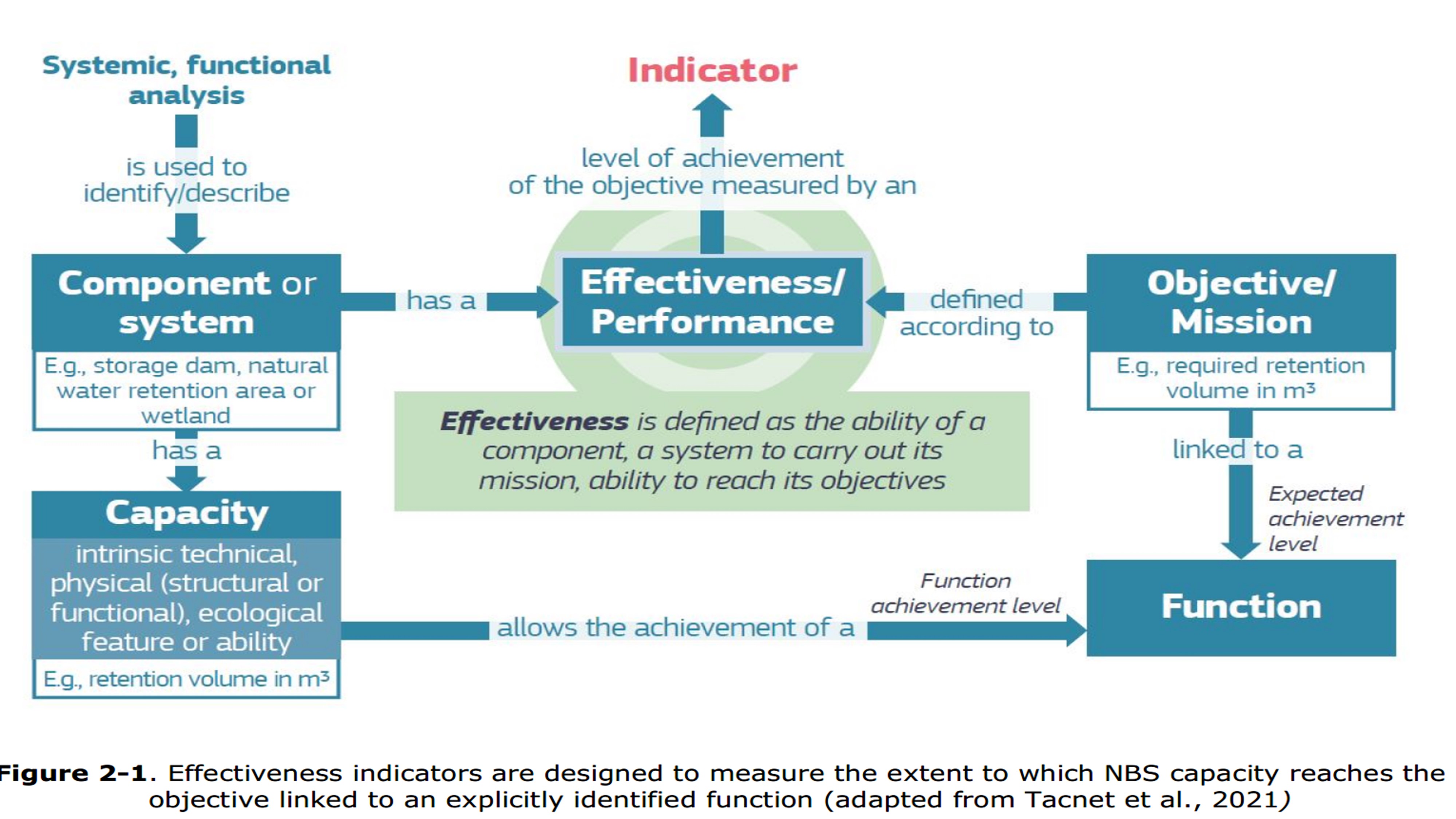
Assessment of NBS focus on the verification and improvement of NBS quality, efficiency and effectivness at different stages of the implementation (EC 2021). According to the European Commision, there are (in general) two approaches for assessment:
- NBS has already been developed in the past and the main aim is to determine whether the NBS intervention is effective (retrospective impact evaluation, i.e., ex-post evaluation). If NBS is already there and baseline data was not collected before the NBS was implemented, it is difficult to analyse whether the NBS is successfully implemented and whether the envisioned outcomes are achieved (challenges related to the selection of appropriate treated and control groups before the implementation). However, this can be done for specific indicators using data that was collected during the monitoring of the NBS and data collected for other purposes (e.g., regional statistics of city administration data).
- NBS has to be chosen during the planning phase (in comparison to alternative solutions or business-as-usual, i.e., ex-ante evaluation including screening) and implemented. Impact evaluations are developed at the same time as the NBS intervention is being planned and are integrated into the NBS implementation (prospective impact evaluation, i.e., ex-ante evaluation including screening). Baseline data are collected before the NBS intervention is implemented for both the area and/or group receiving the intervention (the treated area/group) and the area/group used for comparison that is not receiving the intervention (the control area/group).
Multi-criteria decision analysis is a possibility to gather qualitative and quantitative criteria, which corresponds to NBS impacts (EC 2021).
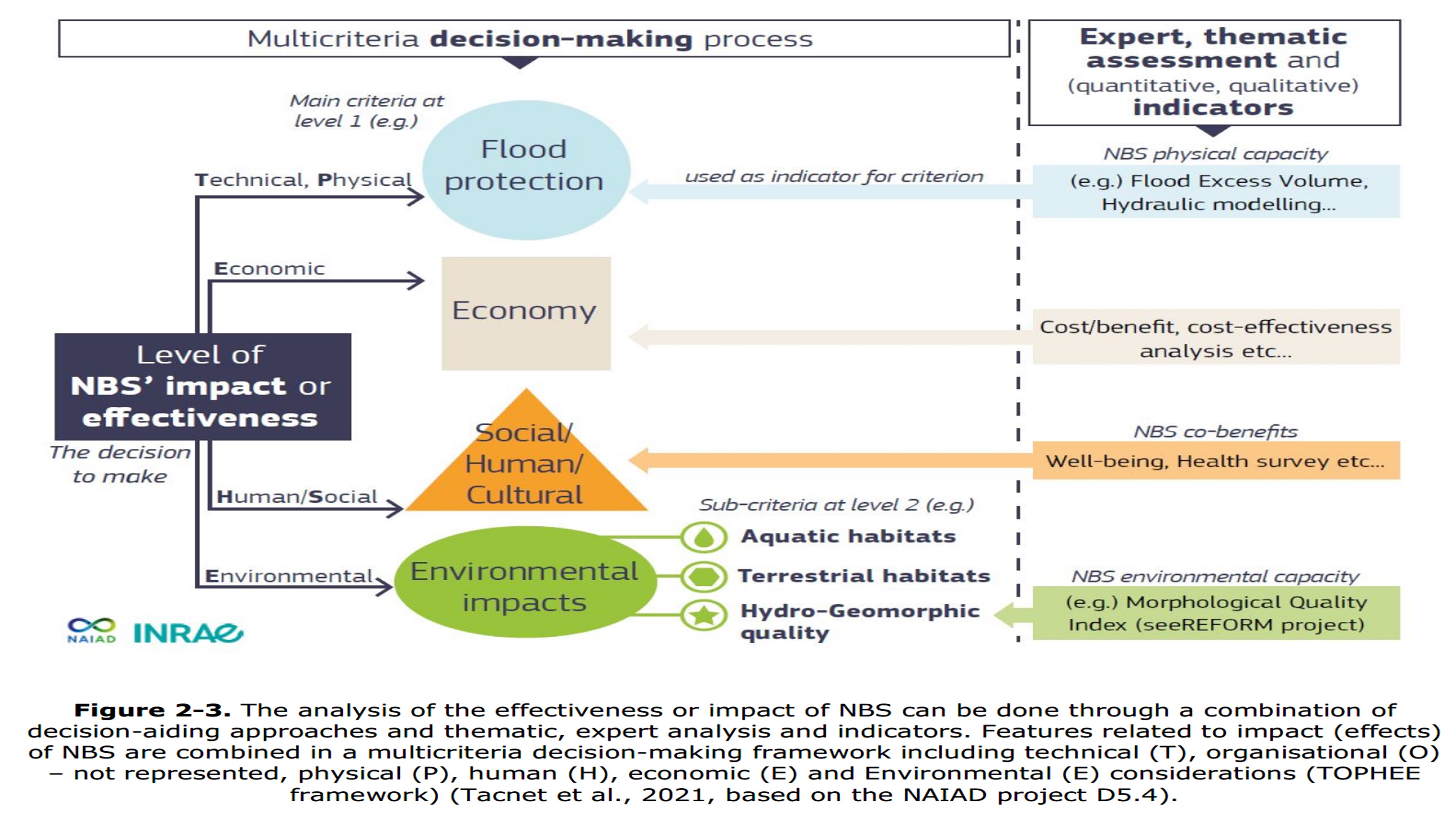
Further Viewing
M.Sc. Angelika Gruhn, Prof. Dr.-Ing. Peter Fröhle (2021) | Nature-based Solutions: from definition to implementation (September 2020) | CC BY-SA 4.0
M.Sc. Angelika Gruhn, Prof. Dr.-Ing. Peter Fröhle (2021) | Ecosystem-Based Management | CC BY-SA 4.0
Further Reading
- Cohen-Shacham, E.; Walter, G.; Janzen, C.; and Maginnis, S. (eds.) (2016): Nature-based Solutions to address global societal challenges, Gland, Switzerland: IUCN, xiii+97pp, Doi: https://doi.org/10.2305/IUCN.CH.2016.13.en
- European Commission (2021): Evaluating the impact of nature-based solutions – A Handbook for Practitioners, Independent Expert Report, Dumitru, A.; Wendling, L. (eds.), European Commission, Directorate-General for Research and Innovation, Directorate C-Healthy Planet
- European Commission (2021): Evaluating the impact of nature-based solutions – Appendix of Methods, Independent Expert Report, Dumitru, A.; Wendling, L. (eds.), European Commission, Directorate-General for Research and Innovation, Directorate C-Healthy Planet
- IUCN (2020): Guidance for using the IUCN Global Standard for Nature-based Solutions-Auser-friendly framework for the verification, design and scaling up of Nature-based Solutions, First Edition, Gland, Switzerland: IUCN, DOI: https://doi.org/10.2305/IUCN.CH.2020.09.en
- Lo, V. (2016): Synthesis report on experience with ecosystem-based approaches to climate change adaptation and disaster risk reduction, Technical Series No. 85, Secretariat of the Convention on Biological Diversity, Montreal, 106 pages
- Millennium Ecosystem Assessment (2005): Ecosystems and Human Well-being: Synthesis, Island Press, Washington, DC
- Sudmeier-Rieux, K.; Nehren, U.; Sandholz, S. and Doswald, N. (2019): Disasters and Ecosystems, Resilience in a Changing Climate – Source Book, Geneva: UNEP and Cologne: TH Köln – University of Applied Sciences
- UNDRR (2020): Ecosystem-Based Disaster Risk Reduction: Implementing Nature-Based Solutions for Resilience, United Nations Office for Disaster Risk Reduction-Regional Office for Asia and the Pacific, Bangkok, Thailand
- Von Unger, M.; Herr, D.; Seneviratne, Th.; Castillo, G. (2020): Blue Nature-based Solutions in Nationally Determined Contributions – A Booklet for Successful Implementation, GIZ 2020
References
- European Commission (2021): Evaluating the impact of nature-based solutions – A Handbook for Practitioners, Independent Expert Report, Dumitru, A.; Wendling, L. (eds.), European Commission, Directorate-General for Research and Innovation, Directorate C-Healthy Planet
- Jordan, P. and P. Fröhle (2021): Bridging the Gap between Coastal Engineering and Nature Conservation? A Review of Coastal Ecosystems as Nature-based Solutions for Coastal Protection, In: Journal of Coastal Conservation, under review
Zuletzt geändert: Sonntag, 8. September 2024, 20:22